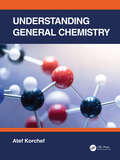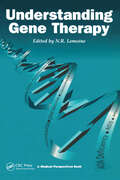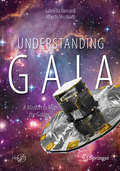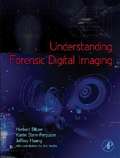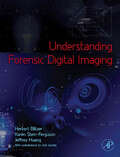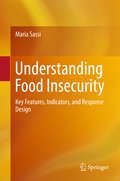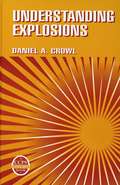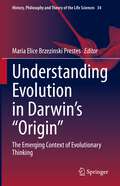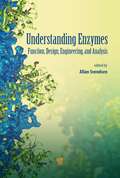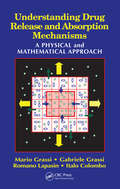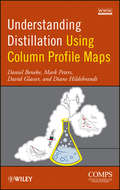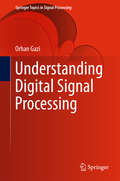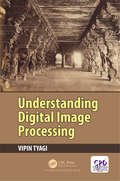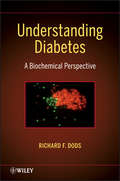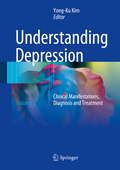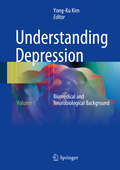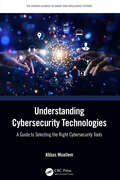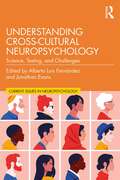- Table View
- List View
Understanding General Chemistry
by Atef KorchefUnderstanding General Chemistry details the fundamentals of general chemistry through a wide range of topics, relating the structure of atoms and molecules to the properties of matter. Written in an easy-to-understand format with helpful pedagogy to fuel learning, the book features main objectives at the beginning of each chapter, get smart sections, and check your reading section at the end of each chapter. The text is filled with examples and practices that illustrate the concepts at hand. In addition, a summary, and extensive MCQs, exercises and problems with the corresponding answers and explanations are readily available. Additional features include: Alerts students to common mistakes and explains in simple ways and clear applications how to avoid these mistakes. Offers answers and comments alongside sample problems enabling students to self-evaluate their skill level. Includes powerful methods, easy steps, simple and accurate interpretations, and engaging applications to help students understand complex principles. Provides a bridge to more complex topics such as solid-state chemistry, organometallic chemistry, chemistry of main group elements, inorganic chemistry, and physical chemistry. This introductory textbook is ideal for chemistry courses for non-science majors as well as health sciences and preparatory engineering students.
Understanding Gene Therapy
by Prof Nick LemoineThis title explains what gene therapy is, how genes are delivered and how they are targeted. It discusses recent gene therapy trials, future applications and considers the ethical and safety issues surrounding gene therapy. Understanding Gene Therapy is a
Understanding Gene Therapy
by Prof Nick LemoineThis title explains what gene therapy is, how genes are delivered and how they are targeted. It discusses recent gene therapy trials, future applications and considers the ethical and safety issues surrounding gene therapy. Understanding Gene Therapy is a
Understanding Gaia: A Mission to Map the Galaxy (Springer Praxis Books)
by Gabriella Bernardi Alberto VecchiatoThis book is the first to provide a comprehensive, readily understandable report on the European Space Agency’s Gaia mission that will meet the needs of a general audience. It takes the reader on an exciting journey of discovery, explaining how such a scientific satellite is made, presenting the scientific results available from Gaia to date, and examining how the collected data will be used and their likely scientific consequences. The Gaia mission will provide a complete and high-precision map of the positions, distances, and motions of the stars in our galaxy. It will revolutionize our knowledge on the origin and evolution of the Milky Way, on the effects of mysterious dark matter, and on the birth and evolution of stars and extrasolar planets. The Gaia satellite was launched in December 2013 and has a foreseen operational lifetime of five to six years, culminating in a final stellar catalogue in the early 2020s. This book will appeal to all who have an interest in the mission and the profound impact that it will have on astronomy.
Understanding Forensic Digital Imaging (PDF)
by Herbert L. Blitzer Karen Stein-Ferguson Jeffrey HuangUnderstanding Forensic Digital Imaging offers the principles of forensic digital imaging and photography in a manner that is straightforward and easy to digest for the professional and student. It provides information on how to photograph any setting that may have forensic value, details how to follow practices that are acceptable in court, and recommends what variety of hardware and software are most valuable to a practitioner. In addition to chapters on basic topics such as light and lenses, resolution, and file formats, the book contains forensic-science-specific information on SWGIT and the use of photography in investigations and in court. Of particular note is Chapter 17, Establishing Quality Requirements, which offers information on how to create a good digital image, and is more comprehensive than any other source currently available. Covers topics that are of vital importance to the practicing professional Serves as an up-to-date reference in the rapidly evolving world of digital imaging Uses clear and concise language so that any reader can understand the technology and science behind digital imaging
Understanding Forensic Digital Imaging
by Herbert L. Blitzer Karen Stein-Ferguson Jeffrey HuangUnderstanding Forensic Digital Imaging offers the principles of forensic digital imaging and photography in a manner that is straightforward and easy to digest for the professional and student. It provides information on how to photograph any setting that may have forensic value, details how to follow practices that are acceptable in court, and recommends what variety of hardware and software are most valuable to a practitioner. In addition to chapters on basic topics such as light and lenses, resolution, and file formats, the book contains forensic-science-specific information on SWGIT and the use of photography in investigations and in court. Of particular note is Chapter 17, Establishing Quality Requirements, which offers information on how to create a good digital image, and is more comprehensive than any other source currently available.Covers topics that are of vital importance to the practicing professionalServes as an up-to-date reference in the rapidly evolving world of digital imagingUses clear and concise language so that any reader can understand the technology and science behind digital imaging
Understanding Food Insecurity: Key Features, Indicators, and Response Design
by Maria SassiThis book provides a comprehensive overview of key aspects of food insecurity, including definitional and conceptual issues, information systems and data sources, indicators, and policies. The aim is to equip readers with a sound understanding of the subject that will assist in the recognition of food insecurity and the design of suitable responses. The early chapters discuss the evolution and limitations of the concept and provide a set of conceptual frameworks for the analysis of food security. Systems used to collect data and their evolution over time are then explained, and the most commonly adopted indicators for monitoring food security are presented. Approaches to food security are then thoroughly reviewed decade by decade. Specific attention is paid to the food insecurity challenge in the new millennium, focusing particularly on recent food crises and institutional and policy-related consequences. Finally, the specific terminology of food aid and assistance is examined, with discussion of the instruments recently adopted in the food aid system. This book will be an informative and stimulating resource for both students and professionals.
Understanding Fluorescein Angiography, Fluoreszeinangiografie verstehen, Entendiendo Angiografía con Fluoresceína
by Manfred SpitznasFluorescein angiography is an indispensable tool in ophthalmology. It is founded on the evaluation of phenomena related to the behavior intravenously administered sodium fluorescein in the tissues of the ocular fundus. This book deals with the morphological prerequisites and structural changes on which the individual phenomena are based. It provides the retina specialist, the general ophthalmologist, and the basic scientist with valuable information toward understanding the nature and mechanism of the underlying disorders.
Understanding Explosions (A CCPS Concept Book #16)
by Daniel A. CrowlThere are many different types of explosions, each with its own complex mechanism. Understanding explosions is important in preventing them. This reference provides valuable information on explosions for everyone involved in the operation, design, maintenance, and management of chemical processes, helping enhance understanding of the nature of explosions and the practical methods required to prevent them from occurring. The text includes: Fundamental basis for explosions Explosive and flammable behavior and characteristics of materials Different types of explosions Fire and explosion hazard recognition Practical methods for preventing explosions or minimizing the potential consequences Additional references Understanding Explosions provides a practical understanding of explosion fundamentals, including the different types of explosions, the explosive and flammable behavior of materials, and the hazards related to fires and explosions. It also discusses practical methods to prevent and minimize the probability and consequence of an explosion during routine use of flammable, combustible and/or reactive materials.
Understanding Evolution in Darwin's "Origin": The Emerging Context of Evolutionary Thinking (History, Philosophy and Theory of the Life Sciences #34)
by Maria Elice Brzezinski PrestesThis book aims to encourage the reading of "On the Origin of Species" and to include it in the teaching of evolution. With a comprehensive overview of the development of Darwin's theory, the volume provides relevant aspects of Darwin's life and work in connection with the broader context of his time. The historical and philosophical analysis, mirrored in the socio-cultural scope, enables the diachronic reading of the text. It is built on various sources of historians and philosophers of science and sheds fresh light on them. Its uniqueness is the broad structure that covers four parts: the pre-Darwinian concepts of species changes; some key elements of Darwin's pursuit of the causes of evolution, from his voyage on Beagle to the publication of his groundbreaking work; chapter-by-chapter analysis of the "Origin"; and subsequent developments in evolutionary thought. This book is of interest to undergraduate and graduate students, scholars in history, philosophy, and sociology of science and science education, as well as the general public.
Understanding Enzymes: Function, Design, Engineering, and Analysis
by Allan SvendsenUnderstanding Enzymes: Function, Design, Engineering, and Analysis focuses on the understanding of enzyme function and optimization gained in the past decade, past enzyme function analysis, enzyme engineering, and growing insights from the simulation work and nanotechnology measurement of enzymes in action in vitro or in silico. The book also prese
Understanding Environmental Issues (PDF)
by Susan Buckingham Mike Turner"Understanding Environmental Issues provides an excellent foundation for developing critical thinking about contemporary environmental concerns and the ways in which these are debated, represented and managed. The book should achieve its aim of stimulating students to engage with how ideas of sustainability and environmental justice can be applied both in policy and in practical action." - Gordon Walker, Lancaster Environment Centre, Lancaster University "The arena of environmental issues is a minefield for undergraduate students seeking clarity about key problems and solutions. This is where Understanding Environmental Issues will play a major role, providing a stimulating guide through the wealth of material and complex ideas. In particular the unification of social and physical science in the case studies provides a holistic approach to the subject that is essential for students and a refreshing innovation for environmental textbooks." - Anna R. Davies, Trinity College, University of Dublin There is now an unprecedented interest in, and concern about, environmental problems. Understanding Environmental Issues explains the science behind these problems, as well as the economic, political, social, and cultural factors which produce and reproduce them. This book: Explains, clearly and concisely, the science and social science necessary to understand environmental issues. Describes - in section one - the philosophies, values, politics, and technologies which contribute to the production of environmental issues. Uses cases on climate change, waste, food, and natural hazards in section two to provide detailed illustration and exemplification of the ideas described in section one. The conclusion, a case study of Mexico City, draws together the key themes Vivid, accessible and pedagogically informed, Understanding Environmental Issues will be a key resource for undergraduate and taught postgraduate students in Geography, Environment, and Ecology; as well as students of the social sciences with an interest in environmental issues.
Understanding Drug Release and Absorption Mechanisms: A Physical and Mathematical Approach
by Mario Grassi Gabriele Grassi Romano Lapasin Italo ColomboDemand for better reliability from drug delivery systems has caused designers and researchers to move away from trial-and-error approaches and toward model-based methods of product development. Developing such models requires cross-disciplinary physical, mathematical, and physiological knowledge. Combining these areas under a single cover, Under
Understanding Distillation Using Column Profile Maps
by Daniel Beneke Mark Peters David Glasser Diane HildebrandtResearchers share their pioneering graphical method for designing almost any distillation structure Developed by the authors in collaboration with other researchers at the Centre of Material and Process Synthesis, column profile maps (CPMs) enable chemical engineers to design almost any distillation structure using novel graphical techniques. The CPM method offers tremendous advantages over other design methods because it is generalized and not constrained to a particular piece of equipment. Understanding Distillation Using Column Profile Maps enables readers to understand, analyze, and design distillation structures to solve common distillation problems, including distillation by simple columns, side rectifiers and strippers, multiple feed columns, and fully thermally coupled columns. In addition, the book presents advanced topics such as reactive distillation, membrane permeation, and validation of thermodynamic models. For all these processes, the authors set forth easy-to-follow design techniques, solution strategies, and insights gained using CPMs. This book offers everything needed to fully understand and use CPMs as a design tool: Figures help readers understand how to use CPMs as design and optimization tools Examples clearly illustrate how to solve specific problems using CPMs Tutorials allow readers to explore key concepts through experimentation Design and Optimization of Distillation Systems software package, developed for this book, enables readers to reproduce the examples in the book, follow the tutorials, and begin designing their own distillation systems With its many examples and step-by-step tutorials, Understanding Distillation Using Column Profile Maps is recommended for students in chemical engineering in advanced undergraduate and graduate courses. The book also provides new practical techniques that can be immediately applied by chemical engineering professionals in industry.
Understanding Distillation Using Column Profile Maps
by Daniel Beneke Mark Peters David Glasser Diane HildebrandtResearchers share their pioneering graphical method for designing almost any distillation structure Developed by the authors in collaboration with other researchers at the Centre of Material and Process Synthesis, column profile maps (CPMs) enable chemical engineers to design almost any distillation structure using novel graphical techniques. The CPM method offers tremendous advantages over other design methods because it is generalized and not constrained to a particular piece of equipment. Understanding Distillation Using Column Profile Maps enables readers to understand, analyze, and design distillation structures to solve common distillation problems, including distillation by simple columns, side rectifiers and strippers, multiple feed columns, and fully thermally coupled columns. In addition, the book presents advanced topics such as reactive distillation, membrane permeation, and validation of thermodynamic models. For all these processes, the authors set forth easy-to-follow design techniques, solution strategies, and insights gained using CPMs. This book offers everything needed to fully understand and use CPMs as a design tool: Figures help readers understand how to use CPMs as design and optimization tools Examples clearly illustrate how to solve specific problems using CPMs Tutorials allow readers to explore key concepts through experimentation Design and Optimization of Distillation Systems software package, developed for this book, enables readers to reproduce the examples in the book, follow the tutorials, and begin designing their own distillation systems With its many examples and step-by-step tutorials, Understanding Distillation Using Column Profile Maps is recommended for students in chemical engineering in advanced undergraduate and graduate courses. The book also provides new practical techniques that can be immediately applied by chemical engineering professionals in industry.
Understanding Digital Signal Processing (Springer Topics in Signal Processing #13)
by Orhan GaziThis book explains digital signal processing topics in detail, with a particular focus on ease of understanding. Accordingly, it includes a wealth of examples to aid in comprehension, and stresses simplicity. The book is divided into four chapters, which respectively address the topics sampling of continuous time signals; multirate signal processing; the discrete Fourier transform; and filter design concepts. It provides original practical techniques to draw the spectrum of aliased signals, together with well-designed numerical examples to illustrate the operation of the fast transforms, filter algorithms, and circuit designs. Readers of this book should already have some basic understanding of signals and transforms. They will learn fundamental concepts for signals and systems, as the focus is more on digital signal processing concepts rather than continuous time signal processing topics.
Understanding Digital Image Processing
by Vipin TyagiThis book introduces the fundamental concepts of modern digital image processing. It aims to help the students, scientists, and practitioners to understand the concepts through clear explanations, illustrations and examples. The discussion of the general concepts is supplemented with examples from applications and ready-to-use implementations of concepts in MATLAB®. Program code of some important concepts in programming language 'C' is provided. To explain the concepts, MATLAB® functions are used throughout the book. MATLAB® Version 9.3 (R2017b), Image Acquisition Toolbox Version 5.3 (R2017b), Image Processing Toolbox, Version 10.1 (R2017b) have been used to create the book material. Meant for students and practicing engineers, this book provides a clear, comprehensive and up-to-date introduction to Digital Image Processing in a pragmatic manner.
Understanding Digital Image Processing
by Vipin TyagiThis book introduces the fundamental concepts of modern digital image processing. It aims to help the students, scientists, and practitioners to understand the concepts through clear explanations, illustrations and examples. The discussion of the general concepts is supplemented with examples from applications and ready-to-use implementations of concepts in MATLAB®. Program code of some important concepts in programming language 'C' is provided. To explain the concepts, MATLAB® functions are used throughout the book. MATLAB® Version 9.3 (R2017b), Image Acquisition Toolbox Version 5.3 (R2017b), Image Processing Toolbox, Version 10.1 (R2017b) have been used to create the book material. Meant for students and practicing engineers, this book provides a clear, comprehensive and up-to-date introduction to Digital Image Processing in a pragmatic manner.
Understanding Diabetes: A Biochemical Perspective
by R. F. DodsA clear explanation of the cause, diagnosis, and treatment of diabetes Written for a broad range of readers, including students, researchers, policymakers, health care providers, and diabetes patients and caregivers, this book explains the underlying biochemistry and physiology of diabetes mellitus. Each chapter contains a glossary that defines key terms, a summary that highlights essential concepts discussed in each section of the chapter, as well as a set of simple problems to help readers gain a richer and deeper understanding of diabetes, from its history to treatment options. Understanding Diabetes begins with an overview of the disease, its worldwide prevalence and cost, and its connection to the global obesity epidemic. The author then explores the history of diabetes, including the first documented description of the disease dating back to 3400 BCE in Ancient Egypt. The next chapter, A Glucose Metabolism Primer, sets forth the pathways for the metabolism of glucose. Next, the book covers: Regulation of glucose metabolism and glucose metabolism gone wrong Diabetes classification system Diagnosis, including current laboratory tests Complications, such as retinopathy, neuropathy, and cardiovascular disease Hereditary transmission Prevention and treatment, including emerging research Although a cure has still not been found, this book demonstrates that researchers are continuing to make major breakthroughs on all fronts in the fight against diabetes, including a better understanding of its causes and an improved ability to diagnose and treat the disease.
Understanding Diabetes: A Biochemical Perspective
by R. F. DodsA clear explanation of the cause, diagnosis, and treatment of diabetes Written for a broad range of readers, including students, researchers, policymakers, health care providers, and diabetes patients and caregivers, this book explains the underlying biochemistry and physiology of diabetes mellitus. Each chapter contains a glossary that defines key terms, a summary that highlights essential concepts discussed in each section of the chapter, as well as a set of simple problems to help readers gain a richer and deeper understanding of diabetes, from its history to treatment options. Understanding Diabetes begins with an overview of the disease, its worldwide prevalence and cost, and its connection to the global obesity epidemic. The author then explores the history of diabetes, including the first documented description of the disease dating back to 3400 BCE in Ancient Egypt. The next chapter, A Glucose Metabolism Primer, sets forth the pathways for the metabolism of glucose. Next, the book covers: Regulation of glucose metabolism and glucose metabolism gone wrong Diabetes classification system Diagnosis, including current laboratory tests Complications, such as retinopathy, neuropathy, and cardiovascular disease Hereditary transmission Prevention and treatment, including emerging research Although a cure has still not been found, this book demonstrates that researchers are continuing to make major breakthroughs on all fronts in the fight against diabetes, including a better understanding of its causes and an improved ability to diagnose and treat the disease.
Understanding Depression: Volume 2. Clinical Manifestations, Diagnosis and Treatment
by Yong-Ku KimThis book, in two volumes, focuses on contemporary issues and dilemmas in relation to depression. The aim is to equip readers with an up-to-date understanding of the clinical and neurobiological underpinnings of depression, the clinical manifestations, and the development of more effective treatments. This second volume is devoted specifically to clinical and management issues. Readers will find detailed information on a wide range of frequently encountered and more complicated clinical presentations, with examination of risk factors and links to other conditions. Diagnostic aspects, including progress toward biological classification and the role of neuroimaging, are explored. Current trends in therapy are examined at length, drawing on the latest evidence and covering not only antidepressant medications but also the roles of neurostimulation, combined pharmacotherapy and psychotherapy, mindfulness-based cognitive therapy, and complementary and alternative medicine. The companion volume is dedicated to the underlying biomedical and neurobiological basis of depression. Understanding Depression will be an excellent source of information for both researchers and practitioners in the field.
Understanding Depression: Volume 1. Biomedical and Neurobiological Background
by Yong-Ku KimThis book, in two volumes, focuses on contemporary issues and dilemmas in relation to depression. The aim is to equip readers with an up-to-date understanding of the clinical and neurobiological underpinnings of depression and their relation to clinical manifestations and the development of more effective treatments. This first volume is devoted specifically to biomedical and neurobiological issues. Detailed information is presented on a wide range of topics, including genetics, molecular and cellular biology, and aspects at the neural circuit and multicellular system levels. Readers will gain a deeper appreciation of the factors and interactions underlying individual variation in responsiveness to stress and vulnerability to depression, as well as a clear understanding of potential treatment targets and causes of treatment resistance based on the latest research. A concluding section considers progress towards precision psychiatry and gender and cultural differences in depression. The companion volume is dedicated to clinical and management issues in depression. Understanding Depression will be an excellent source of information for both researchers and practitioners in the field.
Understanding Cybersecurity Technologies: A Guide to Selecting the Right Cybersecurity Tools (The Human Element in Smart and Intelligent Systems)
by Abbas MoallemCyberattacks on enterprises, government institutions, and individuals are exponentially growing. At the same time, the number of companies, both small and large, offering all types of solutions has been increasing too. Since companies rely on technological solutions to protect themselves against cyberattacks, understanding and selecting the right solutions among those offered presents a significant challenge for professionals, company executives, and newcomers to the cybersecurity field.FEATURES Presents descriptions for each type of cybersecurity technology and their specifications Explains applications, usages, and offers case studies to enhance comprehension Offers an easy-to-understand classification of existing cybersecurity technologies Provides an understanding of the technologies without getting lost in technical details Focuses on existing technologies used in different solutions, without focusing on the companies that offer these technologies This book is intended to help all professionals new to cybersecurity, students, and experts to learn or educate their audiences on the foundations of the available solutions.
Understanding Cybersecurity Technologies: A Guide to Selecting the Right Cybersecurity Tools (The Human Element in Smart and Intelligent Systems)
by Abbas MoallemCyberattacks on enterprises, government institutions, and individuals are exponentially growing. At the same time, the number of companies, both small and large, offering all types of solutions has been increasing too. Since companies rely on technological solutions to protect themselves against cyberattacks, understanding and selecting the right solutions among those offered presents a significant challenge for professionals, company executives, and newcomers to the cybersecurity field.FEATURES Presents descriptions for each type of cybersecurity technology and their specifications Explains applications, usages, and offers case studies to enhance comprehension Offers an easy-to-understand classification of existing cybersecurity technologies Provides an understanding of the technologies without getting lost in technical details Focuses on existing technologies used in different solutions, without focusing on the companies that offer these technologies This book is intended to help all professionals new to cybersecurity, students, and experts to learn or educate their audiences on the foundations of the available solutions.
Understanding Cross-Cultural Neuropsychology: Science, Testing and Challenges (Current Issues in Neuropsychology)
by Alberto Luis FernándezUnderstanding Cross-Cultural Neuropsychology thoroughly examines the meaning of culture in the context of neuropsychology, focusing on the fundamental neuroscience underlying how different aspects of culture influence neuropsychological test performance, and how that is related to brain function. It explores in detail the relationship between brain activity and culture, and the influence of various cultural, educational, and linguistic factors on neuropsychological test performances across various cognitive domains. Written by leadings researchers in cross-cultural neuropsychology, the book first introduces the basic concepts in the field. It goes on to focus on the influence of cultural variables on specific domains of cognition, including perception, attention, memory, language, and executive functions. It also explores the implications of cross-cultural neuropsychology in practice, including a focus on test adaptation, the use of interpreters, the influence of acculturation, and the practice of neuropsychological rehabilitation in different cultural settings. This book is essential reading for neuropsychologists and related practitioners working with culturally diverse clients, who need a good grasp of the cultural impacts on neuropsychological test performance when assessing clients from different cultural, linguistic, and educational backgrounds. It is also valuable for neuropsychologists in countries around the world who need a means of understanding the ways in which their culture impacts the performances of their clients on tests, which have been mostly developed in the U.S. or other Western cultures.
